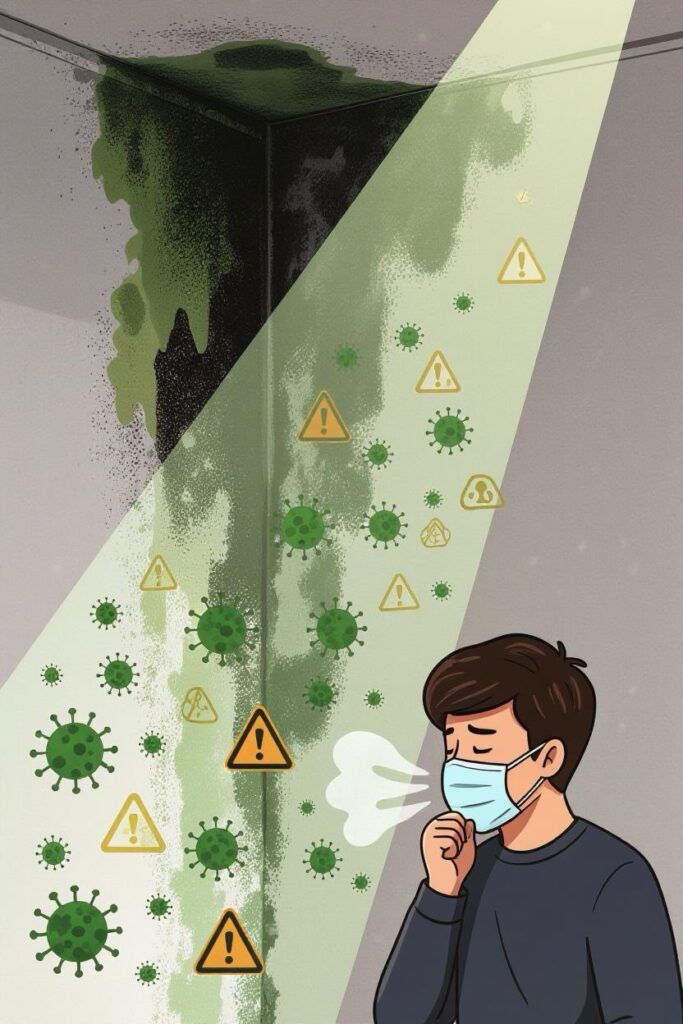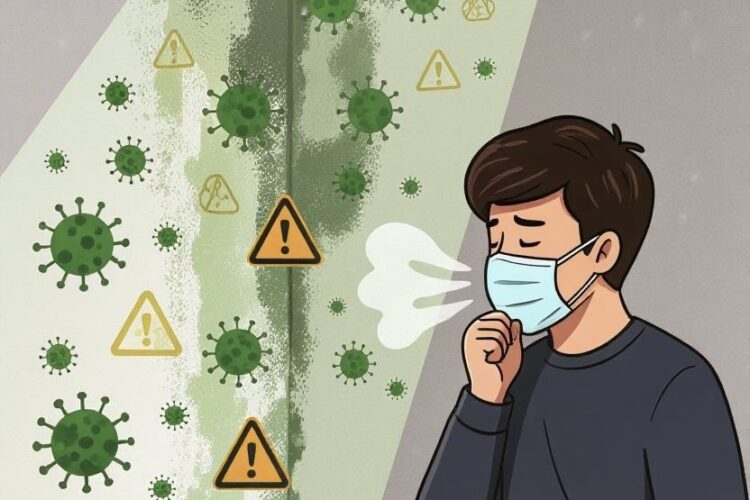Mold, a fungus thriving in damp areas, releases spores and mVOCs that trigger immune responses when inhaled. The immune system detects mold via receptors like Dectin-1, prompting neutrophils and mast cells to release histamine, cytokines (IL-1β, TNF-alpha), and leukotrienes, causing inflammation. This leads to allergies, asthma, sneezing, itchy eyes, and sinus issues. Mycotoxins like gliotoxin suppress immunity, causing oxidative stress and chronic inflammatory response syndrome (CIRS). In immunocompromised individuals, mold can cause severe infections like aspergillosis or mucormycosis. Long-term exposure may lead to neuroinflammation and increased cancer risks. Diagnosis involves allergy tests, fungal cultures, and biopsies, while treatment includes antifungals, corticosteroids, and antioxidants like NAC. Mold remediation, ventilation, and HEPA filters prevent exposure. Understanding mold’s impact helps manage health risks effectively.
Long Version
How Mold Affects the Immune System
Mold, a type of fungus that thrives in damp environments, releases airborne particles like spores and microbial volatile organic compounds (mVOCs) that can infiltrate homes, workplaces, and outdoor spaces. Common varieties such as black mold, mildew, Alternaria, Aspergillus fumigatus, Cladosporium, Penicillium, and yeasts produce these elements, which act as foreign invaders when inhaled or ingested. Inhalation of mold spores triggers the body’s defense mechanism, engaging the immune system in ways that range from mild allergic reactions to severe immune system dysregulation. This interaction often leads to inflammation, oxidative stress, and in some cases, chronic conditions, making mold exposure a significant health concern for millions.
Immune Recognition and Initial Response
The immune system identifies mold through pattern recognition receptors (PRRs), including C-type lectin receptors like Dectin-1, which detect beta-glucan in fungal cell walls. This fungal recognition initiates innate immune activation, where neutrophils (neutrophilic granulocytes) and mast cells respond rapidly. Mast cells undergo degranulation, releasing chemical mediators such as histamine, leukotrienes (including leukotriene B4 via LTA4 hydrolase), and proinflammatory cytokines like interleukin-1β (IL-1β), interleukin-6, and tumor necrosis factor-alpha (TNF-alpha). These cytokines and chemokines orchestrate an inflammatory reaction, recruiting more immune cells to combat the perceived threat.
In healthy individuals, this immune priming helps clear the fungus efficiently. However, repeated exposure can overwhelm the system, leading to hypersensitivity. For instance, mold spores act as allergens, prompting the production of immunoglobulin E (IgE antibodies) and allergy-causing antibodies. This hypersensitive immune system response manifests as hay fever-type symptoms, including sneezing, runny nose, stuffy nose, postnasal drip, itchy eyes, watery eyes, dry itchy skin, cough, and upper respiratory allergies. In more severe scenarios, it escalates to restricted breathing, shortness of breath, wheezing, chest tightness, and even severe asthma attacks, particularly in those with mold-induced asthma or pre-existing lung conditions.
Allergic and Hypersensitivity Conditions
Mold allergies are common, with symptoms mirroring asthma symptoms and often exacerbating existing asthma. Exposure to mold allergens can cause allergic reactions, including fever, night sweats, and blisters or ulcers on the skin. Specific conditions like allergic fungal sinusitis arise from fungus in the sinuses, leading to sinus symptoms such as chronic congestion. Allergic bronchopulmonary aspergillosis, a hypersensitivity to Aspergillus species, involves lung inflammation and can progress to invasive mold infections (IMIs) if unchecked.
Hypersensitivity pneumonitis, another inflammatory response, occurs from prolonged inhalation of mold spores, resulting in lung inflammation and sickness behavior like fatigue and weight loss. In these cases, the overly sensitive immune system mounts an exaggerated defense, releasing excessive cytokines in a cytokine release storm that perpetuates peripheral inflammation and central immune activation. Mast cell activation syndrome (MCAS), increasingly linked to mold, involves mast cells overreacting to triggers, amplifying symptoms through histamine and other mediators.
Mycotoxins and Immune Suppression
Beyond spores, molds produce mycotoxins—toxic secondary metabolites like gliotoxin from Aspergillus fumigatus—that exert profound effects on immunotoxicology. These mycotoxins cause immune suppression by inducing white blood cell death, DNA oxidative stress, and oxidative damage through reactive oxygen species (ROS) and free radicals. Gliotoxin, for example, disrupts immune response by inhibiting neutrophil function, promoting apoptosis in immune cells, and crossing the blood-brain barrier to cause neurotoxicity and neuroinflammation. This leads to brain inflammation, with amoeboid microglia and ramified microglia showing increased Iba-1 immunoreactivity, alongside neural cytokine release that mimics autoimmune encephalomyelitis.
Mycotoxins also trigger oxidative stress, depleting antioxidants like glutathione and causing immune system dysregulation. In vulnerable individuals, this results in chronic inflammatory response syndrome (CIRS), a multi-system illness involving proinflammatory cytokine overproduction, mycosis, and persistent inflammation. CIRS often stems from water-damaged buildings, where mVOCs and hyphae exacerbate pathogenicity, leading to symptoms like neuroinflammation, immune stimulation at low doses, and outright suppression at high exposures.
Fungal Infections in Compromised Hosts
For those with weakened immune systems—such as individuals undergoing chemotherapy, organ transplants, tissue transplants, stem cell transplants, or those with cancer like leukemia or lymphoma—mold exposure can lead to invasive fungal infections. Aspergillosis, caused by Aspergillus fumigatus, involves hyphae invading tissues, evading neutrophils and innate immune activation through toxins like gliotoxin. Mucormycosis, another severe infection, thrives in immunocompromised states, leading to biologics-resistant disease.
Invasive mold infections (IMIs) exploit compromised immune systems, with fungal culture, biopsy, histopathology, bronchoalveolar lavage (BAL), and Aspergillus galactomannan tests aiding diagnosis. These infections highlight how mold undermines the body’s defense mechanism, increasing susceptibility to foreign invaders and promoting immune suppression.
Neurological and Systemic Impacts
Mold’s reach extends beyond the lungs, causing systemic effects through inhalation and circulation. It induces lung conditions, but also crosses into the brain, triggering microglia activation and neurotoxicity. This results in autoimmune encephalomyelitis-like states, with IL-1β and TNF-alpha driving inflammation. Symptoms include brain fog, anxiety, and altered pain sensitivity, often linked to peripheral inflammation spilling over centrally.
Vulnerable Populations and Long-Term Risks
Individuals with pre-existing conditions face heightened risks. Those who are immunosuppressed or have undergone chemotherapy are prone to aspergillosis and mucormycosis. Mold exposure can exacerbate cancer risks indirectly by weakening immune surveillance, potentially leading to lymphoma or leukemia progression. Long-term effects include DNA oxidative stress, potentially contributing to carcinogenesis, though direct links require more study.
Diagnosis, Treatment, and Prevention
Diagnosing mold-related issues involves assessing allergy symptoms, fungal culture, biopsy, and tests for IgE antibodies. For CIRS or MCAS, monitoring cytokines and chemokines is key. Treatment includes antifungal medications, corticosteroids for inflammation, and biologics for severe cases. Antioxidants like N-acetyl-cysteine (NAC), glutathione, and supportive therapies combat oxidative stress and ROS.
Mold remediation is essential—address leaks, improve ventilation, and remove contaminated materials to prevent recurrence. Avoiding high-risk environments and using HEPA filters reduces airborne particles and spores.
In summary, mold affects the immune system through direct fungal infection, allergic responses, mycotoxin-induced suppression, and chronic inflammation. Understanding these mechanisms empowers better management, turning a hidden threat into a preventable one.

Hashtags For Social Media
#MoldAwareness #FungalInfection #MoldToxicity #IndoorAirQuality #HealthRisks #CIRS #Neuroinflammation #Mycotoxins #MoldHealth #ChronicIllness #MoldRemediation #AsthmaAwareness #ImmuneSystem #FungalSpores #HealthyHome #MoldFree #AllergyRelief #MoldPrevention #EnvironmentalHealth #MoldSickness #SinusIssues #Corticosteroids #Antifungals #FungalInfections #RespiratoryHealth #ImmuneResponse #MoldTreatment #HEPAfilters #HealthyLiving #NAC #FungalDisease #ToxicMold #VentilationMatters #MoldAwarenessMonth #ChronicInflammation
Related Questions, Words, Phrases
how does mold affect the immune system | effects of mold on immunity | mold exposure and weakened immune response | what happens to your immune system from mold | mold’s impact on immune health | can mold weaken your immune system | mold allergies and immune reactions | how mold triggers immune inflammation | risks of mold for immune-compromised people | mold toxins and immune suppression | does black mold harm immunity | mold spores and allergic immune responses | long-term effects of mold on the immune system | how mold causes chronic immune issues | immune system symptoms from mold exposure | mold and autoimmune reactions | what are mycotoxins’ effects on immunity | mold in home weakening immune defenses | how does mold lead to immune dysregulation | immune boosting tips after mold exposure | aspergillus mold and immune risks | mold-related illnesses affecting immunity | can mold cause low immune function | immune system recovery from mold | effects of damp mold on human immunity | mold hypersensitivity and immune overreaction | how mold influences cytokine production | immune tests for mold exposure | preventing mold’s harm to immune system | mold and oxidative stress on immunity | chronic inflammatory response from mold | how mold crosses blood-brain barrier affecting immunity | immune suppression by gliotoxin in mold | mold-induced asthma and immune impact






